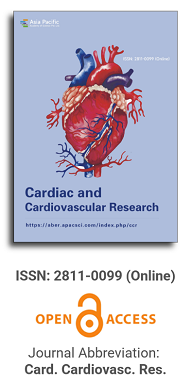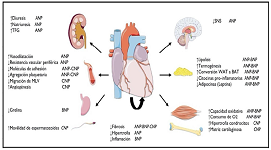
Asia Pacific Academy of Science Pte. Ltd. (APACSCI) specializes in international journal publishing. APACSCI adopts the open access publishing model and provides an important communication bridge for academic groups whose interest fields include engineering, technology, medicine, computer, mathematics, agriculture and forestry, and environment.

Therapeutic effect of cardiac rehabilitation combined cognitive behavioral therapy on kinesiophobia in AMI patients
Vol 3, Issue 2, 2022
Download PDF
Abstract
Objective: To study therapeutic effect of cardiac rehabilitation (CR) combined cognitive behavioral therapy (CBT) on kinesiophobia in patients with acute myocardial infarction (AMI). Methods: A total of 96 AMI patients with kinesiophobia treated in our hospital were divided into CR group (n = 47, were in hospital from September 2020 to January 2021 and received routine CR treatment) and combined intervention group (n = 49, were in hospital from February 2021 to June 2021 and recerved CBT based on CR group), both groups were intervened for three months. General clinical data, scores of Tampa scale for kinesiophobia heart (TSK-SV Heart), anxiety and depression scale and Barthel index (BI) before and after intervention were observed and compared between two groups. Results: During intervention, there was one case dropped out in CR group, and one case dropped out and two cases lost during follow-up in combined intervention group. Compared with CR group, three months after intervention, there were significant reductions in scores of TSK-SV Heart [(36.26 ± 3.16) scores vs. (31.67 ± 3.53) scores], anxiety scale [(7.39 ± 2.05) scores vs. (5.78 ± 1.47) scores] and depression scale [(6.28 ± 2.10) scores vs. (4.65 ± 2.50) scores] and significant rise in BI score [(94.46 ± 4.11) scores vs. (96.41 ± 3.60) scores] in combined intervention group (P < 0.05 or <0.01). Conclusion: CR combined CBT can significantly improve daily self-care living
Keywords
References
- China Cardiovascular Health and Disease Report Compiling Group Summary of China Cardiovascular Health and Disease Report 2019. China Journal of Circulation. 2020; 35(9): 833-854.
- Benjamin EJ, Muntner P, Alonso A, et al. Heart Disease and Stroke Statistics-2019 Update: A Report From the American Heart Association. Circulation. 2019; 139(10): e56-e528.
- Wang R. Research on the process of natural cardiac rehabilitation of patients with acute myocardial infarction based on patient experience. Beijing: Peking Union Medical College; 2018
- Shen X, Zhu X, Wu Y, et al. Effects of a psychological intervention programme on mental stress, coping style and immune function in percutaneous coronary intervention patients. Puebla I, ed. PLOS ONE. 2018; 13(1): e0187745. doi: 10.1371/journal.pone.0187745
- Anderson L, Thompson DR, Oldridge N, et al. Exercise-based cardiac rehabilitation for coronary heart disease. Cochrane Database of Systematic Reviews. Published online January 5, 2016. doi: 10.1002/14651858.cd001800.pub3
- Won MH, Son YJ. Perceived Social Support and Physical Activity Among Patients with Coronary Artery Disease. Western Journal of Nursing Research. 2016; 39(12): 1606-1623. doi: 10.1177/0193945916678374
- Han J, Liu F, Zhang H, et al. Analysis of physical activity status and influencing factors of patients with coronary heart disease after PCI Modern Preventive Medicine. 2020; 47(14): 2677-26802684.
- Hu W. Cultural adaptation of simplified Chinese version of TSK and FABQ scales and their application in degenerative low back and leg pain. Shanghai: Second Military Medical University; 2012
- Brunetti ND, Guerra A, Ieva R, et al. Scared for the scar: fearsome impact of acute cardiovascular disease on perceived kinesiophobia (fear of movement). Clinical Cardiology. 2017; 40(7): 480-484. doi: 10.1002/clc.22682
- Bäck M, Lundberg M, Cider Å, et al. Relevance of Kinesiophobia in Relation to Changes Over Time Among Patients After an Acute Coronary Artery Disease Event. Journal of Cardiopulmonary Rehabilitation and Prevention. 2018; 38(4): 224-230. doi: 10.1097/hcr.0000000000000265
- Cai L, Liu Y, Li Y, et al. Study on the application of multidisciplinary collaborative intervention scheme in patients with phobia after total knee replacement. Chinese Journal of Nursing. 2020; 55(4): 494-499.
- Baykal Şahin H, Kalaycıoğlu E, Şahin M. The effect of cardiac rehabilitation on kinesiophobia in patients with coronary artery disease. Turkish Journal of Physical Medicine and Rehabilitation. 2021; 67(2): 203-210. doi: 10.5606/tftrd.2021.5164
- Thygesen K, Alpert JS, Jaffe AS, et al. Fourth Universal Definition of Myocardial Infarction (2018). Journal of the American College of Cardiology. 2018; 72(18): 2231-2264. doi: 10.1016/j.jacc.2018.08.1038
- Richmond H. Using a CBT approach to manage low back pain. Nurs Times. 2016; 112(18): 12-14.
- Bäck M, Jansson B, Cider Ã, et al. Validation of a questionnaire to detect kinesiophobia (fear of movement) in patients with coronary artery disease. Journal of Rehabilitation Medicine. 2012; 44(4): 363-369. doi: 10.2340/16501977-0942
- Lei M, Liu T, Xiong S, et al. The Sinicization, reliability and validity of the exercise fear scale for patients with heart disease China Nursing Management. 2019; 19(11): 1637-1642.
- Worcester MU, Elliott PC, Turner A, et al. Resumption of work after acute coronary syndrome or coronary artery bypass graft surgery. Heart, Lung and Circulation. 2014; 23(5): 444-453. doi: 10.1016/j.hlc.2013.10.093
- Acar S, Savci S, Keskinoglu P, et al. Tampa Scale of Kinesiophobia for Heart Turkish Version Study: cross-cultural adaptation, exploratory factor analysis, and reliability. J Pain Res. 2016; 9: 445-451.
- Tungare N, Nagarwala R, Shyam A, et al. Factors affecting kinesiophobia in coronary artery disease patients. Physiotherapy. 2020; 14(1): 32-36.
- An H, He RH, Zheng YR, et al. Cognitive-Behavioral Therapy. Adv Exp Med Biol. 2017; 1010: 321-329.
- Boswell JF. Intervention strategies and clinical process in transdiagnostic cognitive-behavioral therapy. Psychotherapy. 2013; 50(3): 381-386. doi: 10.1037/a0032157
- Monticone M, Ambrosini E, Rocca B, et al. RETRACTED: Group-based multimodal exercises integrated with cognitive-behavioural therapy improve disability, pain and quality of life of subjects with chronic neck pain: a randomized controlled trial with one-year follow-up. Clinical Rehabilitation. 2016; 31(6): 742-752. doi: 10.1177/0269215516651979
- Alaca N, Kaba H, Atalay A. Associations between the severity of disability level and fear of movement and pain beliefs in patients with chronic low back pain. Journal of Back and Musculoskeletal Rehabilitation. 2020; 33(5): 785-791. doi: 10.3233/bmr-171039
- Keessen P, Uijl I, Visser B, et al. Corrigendum to Fear of movement in patients attending cardiac rehabilitation: A validation study. Journal of Rehabilitation Medicine. 2020; 52(10): jrm00114. doi: 10.2340/16501977-2749
- Keessen P, Latour CHM, van Duijvenbode ICD, et al. Factors related to fear of movement after acute cardiac hospitalization. BMC Cardiovascular Disorders. 2020; 20(1). doi: 10.1186/s12872-020-01783-9
- Knapik A, Dąbek J, Gallert-Kopyto W, et al. Psychometric Features of the Polish Version of TSK Heart in Elderly Patients with Coronary Artery Disease. Medicina. 2020; 56(9): 467. doi: 10.3390/medicina56090467
- Van Beek MHCT, Roest AM, Wardenaar KJ, et al. The Prognostic Effect of Physical Health Complaints with New Cardiac Events and Mortality in Patients with a Myocardial Infarction. Psychosomatics. 2017; 58(2): 121-131. doi: 10.1016/j.psym.2016.10.009
- Prugger C, Wellmann J, Heidrich J, et al. Regular exercise behaviour and intention and symptoms of anxiety and depression in coronary heart disease patients across Europe: Results from the EUROASPIRE III survey. European Journal of Preventive Cardiology. 2016; 24(1): 84-91. doi: 10.1177/2047487316667781
- Reavell J, Hopkinson M, Clarkesmith D, et al. Effectiveness of Cognitive Behavioral Therapy for Depression and Anxiety in Patients with Cardiovascular Disease: A Systematic Review and Meta-Analysis. Psychosomatic Medicine. 2018; 80(8): 742-753. doi: 10.1097/psy.0000000000000626
- Zhang J, Zhu L, Tang Q. Effect of TCM comprehensive therapy combined with exercise on cardiac rehabilitation of patients with coronary heart disease after PCI Journal of Cardiovascular and Cerebrovascular Diseases of Integrated Traditional Chinese and Western Medicine. 2021; 19(12): 2112-2114.
- Jia H. Effect of resistance exercise on cardiac rehabilitation after PCI in patients with myocardial infarction Nursing Practice and Research. 2018; 15(1): 8-11.
Supporting Agencies
Copyright (c) 2022 Wenmin Guo, Suqin Zhao, Liting Zhao

This work is licensed under a Creative Commons Attribution 4.0 International License.

This site is licensed under a Creative Commons Attribution 4.0 International License (CC BY 4.0).

Prof. Prakash Deedwania
University of California,
San Francisco, United States




